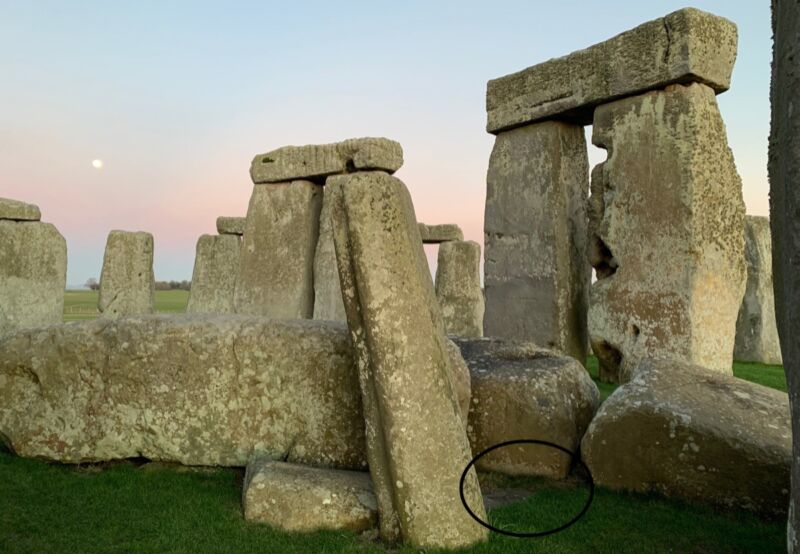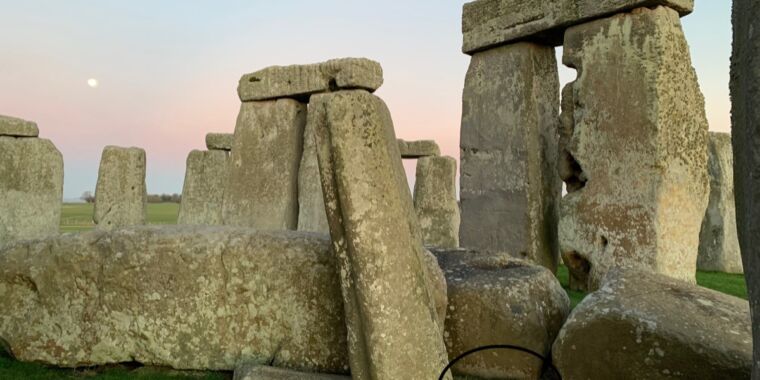
English Heritage
The largest of the “bluestones” that comprise the inner circle at Stonehenge is known as the Altar Stone. Like its neighbors, scientists previously thought the stone had originated in western Wales and been transported some 125 miles to the famous monument that still stands on the Salisbury Plain in Wiltshire, England. But a new paper published in the journal Nature came to a different conclusion based on fresh analysis of its chemical composition: The Altar Stone actually hails from the very northeast corner of Scotland.
“Our analysis found specific mineral grains in the Altar Stone are mostly between 1,000 to 2,000 million years old, while other minerals are around 450 million years old,” said co-author Anthony Clarke, a graduate student at Curtin University in Australia, who grew up in Mynydd Preseli in Wales—origin of most of the bluestones—and first visited the monument when he was just a year old. “This provides a distinct chemical fingerprint suggesting the stone came from rocks in the Orcadian Basin, Scotland, at least 750 kilometers [450 miles] away from Stonehenge.”
As previously reported, Stonehenge consists of an outer circle of vertical sandstone slabs (sarsen stones), connected on top by horizontal lintel stones. There is also an inner ring of smaller bluestones and, within that ring, several free-standing trilithons (larger sarsens joined by one lintel). Radiocarbon dating indicates that the inner ring of bluestones was set in place between 2400 and 2200 BCE. But the standing arrangement of sarsen stones wasn’t erected until around 500 years after the bluestones.
No contemporary written records exist concerning the monument’s construction, and scholars have pondered its likely use and cultural significance for centuries. Stonehenge’s form (and maybe its purpose) changed several times over the centuries, and archaeologists are still trying to piece together the details of its story and the stories of the people who built it and gathered in its circles.
In 2019, Parker Pearson and several colleagues reported the results of their investigation into the quarry source for the bluestones. They found that the 42 bluestones came all the way from western Wales. Chemical analysis has even matched some of them to two particular quarries on the northern slopes of the Preseli Hills.
One quarry, an outcrop called Carn Goedog, seems to have supplied most of the bluish-gray, white-speckled dolerite at Stonehenge. And another outcrop in the valley below, Craig Rhos-y-felin, supplied most of the rhyolite. When another group of archaeologists studied the chemical isotope ratios in the cremated remains of people once buried beneath the bluestones, those researchers found that many of those people may have come from the same part of Wales between 3100 and 2400 BCE.
But the sarsen stones hail from much closer to home. Since the 1500s, most Stonehenge scholars have assumed the sarsen stones came from nearby Marlborough Downs, an area of round, grassy hills 25 to 30km (17 miles) north of Stonehenge, which has the largest concentration of sarsen in the UK. A 2020 study by University of Brighton archaeologist David Nash and colleagues confirmed that.

English Heritage/Curtin University
Fifty of the sarsens shared very similar chemical fingerprints, which means they probably all came from the same place, most likely one site in the southeastern Marlborough Downs: West Woods, about 25 km (16 miles) north of Stonehenge and just 3 km (2 miles) south of where most earlier studies had looked for Neolithic sarsen quarries. The other two surviving sarsens came from two different places, which archaeologists haven’t pinpointed yet.

